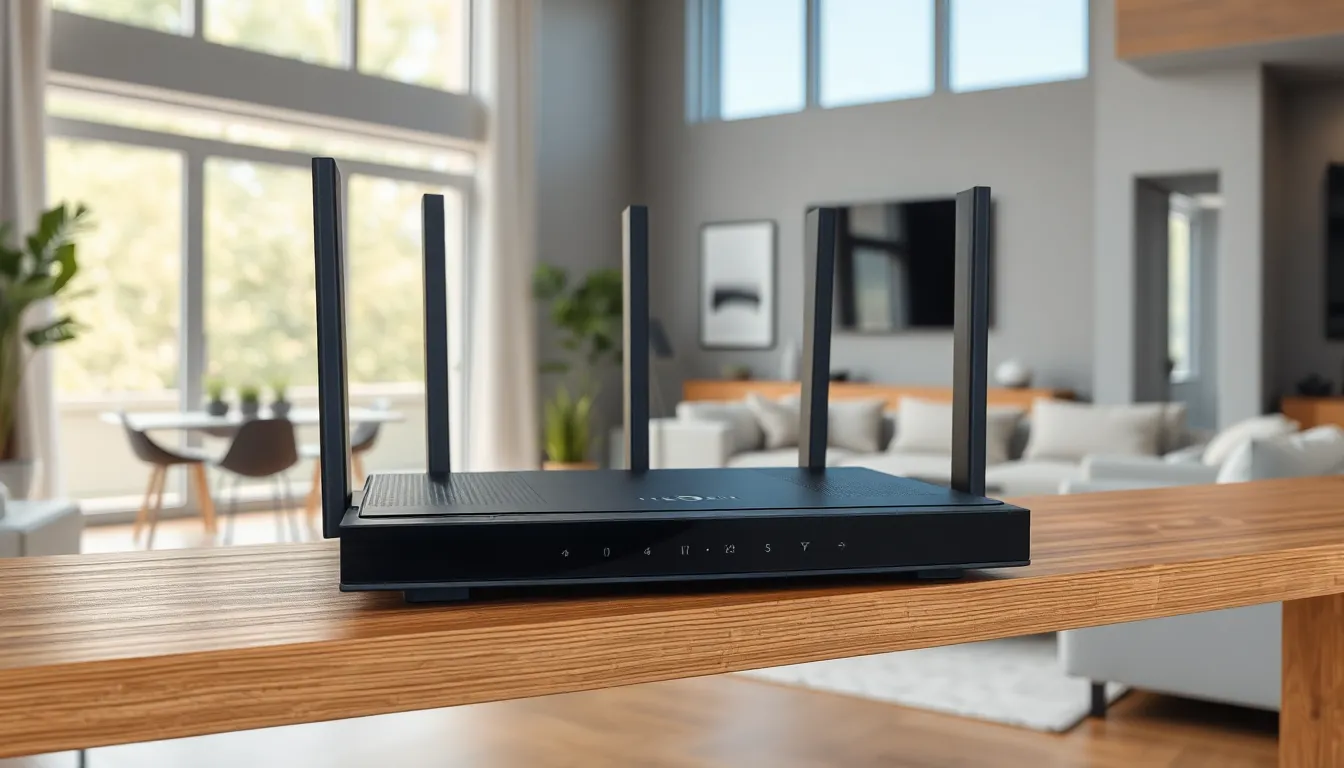In today’s connected world, the placement of a router can make or break a home’s Wi-Fi experience. With the increasing number of devices relying on stable internet connections, understanding the best spots for router installation is crucial. A well-placed router can enhance signal strength, reduce dead zones, and ensure seamless streaming and gaming.
Many people underestimate how physical barriers and interference can affect their Wi-Fi performance. Factors like walls, furniture, and even appliances can disrupt the signal. By strategically positioning the router, one can optimize coverage and speed throughout the home. This article delves into effective router placement strategies to help anyone achieve a reliable and robust internet connection.
Table of Contents
ToggleImportance Of Router Placement
Router placement significantly impacts Wi-Fi performance and user experience. A strategically positioned router enhances signal strength, minimizes dead zones, and optimizes internet speeds.
- Signal Strength: Placing the router in a central location maximizes coverage. Signal strength declines with distance, making proximity crucial for a reliable connection.
- Minimizing Dead Zones: Router placement reduces dead zones effectively. Areas blocked by walls or furniture suffer the most, so positioning the router away from obstructions improves connectivity.
- Impact of Interference: Other electronic devices can interfere with the Wi-Fi signal. Keeping the router clear of devices like microwaves and cordless phones helps maintain a strong signal.
- Streaming and Gaming Performance: Ideal router placement enhances streaming and gaming experiences. Optimal locations ensure minimal lag and buffering, especially for high-bandwidth activities.
- Antenna Orientation: Adjusting antenna position affects signal direction. Vertical antennas typically provide horizontal coverage, while horizontal orientations can extend vertical range.
- Multifloor Homes: For multi-story homes, placing routers on upper levels improves coverage. Signal strength often decreases with height, so positioning routers strategically across floors is essential.
Proper router placement directly influences the efficiency of an internet connection. Investing time in optimizing placement can lead to significant performance gains while reducing connectivity issues.
Factors Influencing Router Placement

Several factors impact router placement, shaping Wi-Fi performance and connectivity throughout the home. Understanding these elements facilitates optimal positioning for enhanced signal strength and coverage.
Signal Range
Signal range defines how far a Wi-Fi signal travels before diminishing. Higher frequency bands, such as 5 GHz, offer faster speeds but shorter ranges. Lower frequency bands, like 2.4 GHz, provide broader coverage but slower speeds. Placing routers at an elevated position can extend their reach, allowing signals to cover greater distances effectively. It’s essential to account for the specific range requirements of devices used in different areas of the home when determining placement.
Obstacles and Interference
Obstacles and interference critically affect signal quality. Physical barriers, including walls, floors, and furniture, can weaken signals considerably. Materials such as concrete, metal, and glass pose significant challenges. Additionally, interference from electronic devices, like microwaves and cordless phones, disrupts Wi-Fi signals. Positioning the router away from these obstacles and potential interference points maximizes signal strength and minimizes connectivity issues.
Room Size and Layout
Room size and layout influence router placement considerably. Larger rooms may require routers placed centrally to ensure adequate coverage across the entire space. For multi-story homes, routers on upper levels enhance connectivity in bedrooms and common areas. Open floor plans facilitate wider signal distribution, while closed-off spaces might necessitate additional access points or extenders to achieve satisfactory performance throughout the home. Understanding these spatial dynamics helps in optimizing router effectiveness.
Best Practices For Router Placement
Effective router placement significantly enhances Wi-Fi performance. Following best practices ensures optimal signal strength and coverage throughout the home.
Central Location
Centering the router in the home maximizes Wi-Fi coverage. Placing the device in a central area minimizes the distance to connected devices. This approach reduces potential dead zones, allowing for more consistent connection quality. Avoid placing routers in corners or near thick walls, which can diminish signal strength. If the home design requires certain adjustments, consider using Wi-Fi extenders or mesh systems to complement central placement.
Elevation and Positioning
Elevating the router boosts its range and minimizes interference. Mounting the router on a wall or placing it on a high shelf helps signals travel farther without obstacles. Positioning antennas vertically enhances horizontal signal coverage, while pointed antennas can direct signals toward specific devices. Additionally, avoiding proximity to electronics, such as microwaves and cordless phones, helps reduce interference. In multi-story homes, placing the router on an upper floor increases connectivity to lower levels.
Common Mistakes To Avoid
Router placement mistakes can severely impact Wi-Fi performance. Avoiding these common errors ensures optimal signal strength and coverage.
Near Wall Limitations
Placing a router directly against a wall can obstruct Wi-Fi signals. Walls, especially thick ones made of concrete or brick, absorb and block signals, leading to reduced range. To maximize coverage, position routers away from walls, ideally at least a few feet from them. Central locations offer better signal distribution throughout the home, which enhances connectivity in all rooms.
Low Placement Issues
Installing a router at low heights, such as on the floor or low furniture, limits its effective range. Wi-Fi signals propagate better from elevated positions. Higher placements, like on shelves or mounted on walls, promote broader coverage and reduce interference from furniture. Elevating the router ensures it reaches devices on different floors and across various distances more effectively.
Effective router placement is crucial for achieving optimal Wi-Fi performance. By strategically positioning the router in a central location and elevating it, users can significantly enhance their internet experience. Avoiding common pitfalls like placing the router near walls or electronic devices can further improve signal strength and reduce interference.
Taking the time to assess the layout of the home and considering factors such as room size and potential obstacles will lead to a more reliable connection. With the right placement and a few best practices in mind, anyone can enjoy seamless streaming and gaming, ensuring that every corner of the home stays connected.



